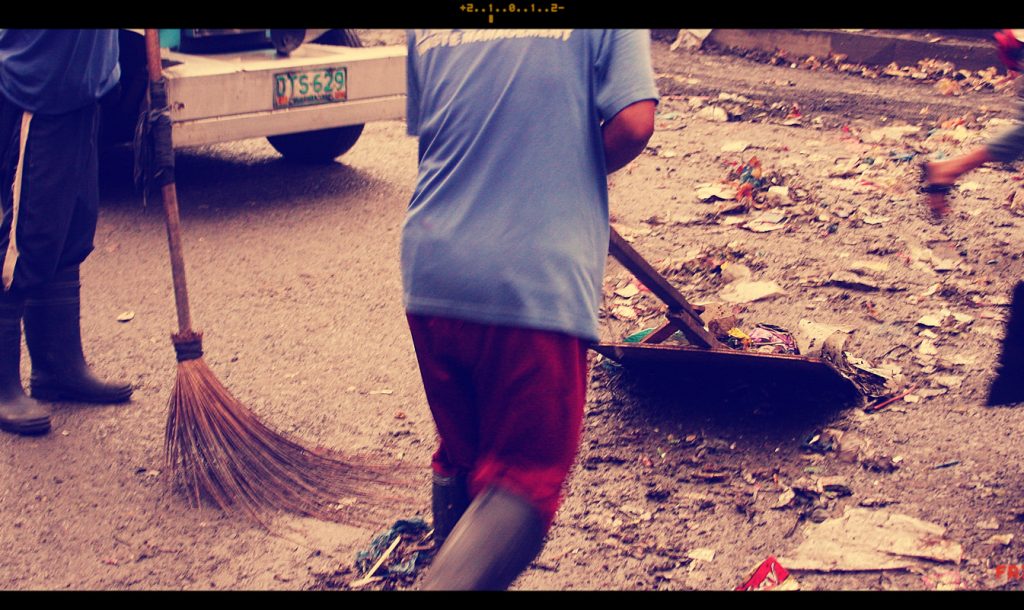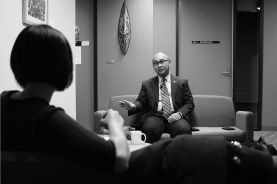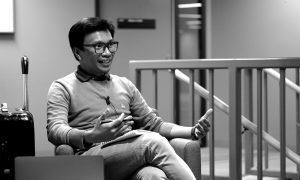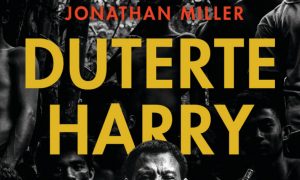President Rodrigo Duterte won on a platform of order and discipline. During his campaigns for the May 2016 elections, he vowed to end drugs and stamp out criminality.
True to his promise, he wasted no time launching an anti-drug campaign, which has led to thousands of arrests and deaths from police operations and extrajudicial killings. Two years later, in June 2018, he put out an anti-loitering directive that has detained/accosted/arrested over 20,000 in Metro Manila.
Critics condemn the illegality, impunity, and the anti-poor bias of these campaigns, but in this essay, I want to approach them from an “aesthetic” angle. I use the term “aesthetic” in its traditional meaning (aisthesis in Greek), which simply pertains to the senses.
Pro-Duterte politics deploys an aesthetic that professes a devotion to cleanliness, which connotes beauty, modernity, progress, efficiency, order, goodness, and discipline. Conversely, it has a marked aversion to dirt, which is associated with ugliness, poverty, crime and disorder. The anti-drug and anti-loitering campaigns have weaponised this aesthetic to deadly effect.
Pro-Duterte politics relies heavily on photos and images. It gives a premium on “seeing” the “beauty” of the president’s accomplishments: clean streets, paved roads, and new infrastructure, among others. This essay unpacks the limits of this visual politics and ends with “aesthetic” reflections on Philippine society.
Dirt and cleanliness in the Philippines
The Philippines is obsessed with beauty and cleanliness. Images of fair-skinned actors fill TV screens and cinemas. Skin-whitening products abound, as do advertisements promising young, clear, rejuvenated skin.
In a society where many Filipinos have naturally brown/tanned skin, fair skin is synonymous with, and constitutive of, beauty, class, wealth, and power. Partly attributed to colonial mentality, a desire for fair skin can be traced to the Spanish and American colonial regimes, whose racial discourses elevated the rich, powerful, and fair-skinned elites over the poor, weak, and brown natives.
Imelda Marcos, First Lady of the Philippines from 1965 to 1986, promoted the beautification of Metro Manila. She patronised the arts and commissioned buildings designed by prominent architects. Today, city governments undertake similar campaigns, though less on the scale of Imelda’s.
Many Filipinos are sensitive to criticisms of Manila’s appearance. They were in an uproar when Dan Brown’s novel, Inferno, tagged the capital as “the gates of hell.” In 1998, President Joseph Estrada sought to ban American actress Claire Danes from the country. She had said that Manila was “ghastly and weird.” It “smelled of cockroaches with rats all over. There is no sewerage system, and the people do not have anything—no arms, no legs, no eyes.”
The obsession with beauty and cleanliness is matched by an aversion to the dirty, delinquent, and disorderly. The Philippine government used billboards to hide the squalor of Metro Manila’s streets during the Miss Universe Pageant of 1974 and the visit of Pope Francis in January 2015. During the November 2017 ASEAN Summit, it sought to “take the homeless off the streets” because of security concerns.
The disdain for dirt often translates into disdain for the poor. In 1896, Emilio Jacinto, the “Brains of the Katipunan,” the revolutionary organisation that fought against Spain, hints at his contemporaries’ demeaning attitudes to the underclass. He writes in an essay, Liwanag at Dilim (Light and Darkness), “Then a pauper comes before us, encumbered by a heavy load. We smile and think: Where did he steal it?] (Original in Filipino)
Many Filipinos link poor taste with the masses. The title of a Get Real Philippines post in 2012 minces no words, “The Truth Is… The Pinoy Masa Loves Ugly Things and Uncivilized Surroundings.” Bakya, baduy, and jologs demean certain forms of Filipino popular culture and the people who patronise them. Even the beloved jeepney—the Philippines’ basic mode of public transportation unit—has received its share of harsh words.
“Jeepneys are an abomination. They encapsulate everything that is wrong with the Filipino — unsafe, mediocre, rehashed from old American technology, inefficient, and chaotic. This “cultural icon” also goes against every bit of modern aesthetic sensibility with its garish decoration and assault-on-the-senses overall looks.”
The scorn extends to politics. In May 2001, the poor took to the streets to support former President Joseph Estrada, who had been ousted earlier that year. In an article, Charles Schaeffer quoted a text message circulating during what came to be called EDSA 3. “Calling all the filthy and ignorant, the toothless and unclothed, let’s prove we have no brains—go to Edsa….” Schaeffer adds that “in the Tagalog-language media, the poor who rallied at EDSA 3 were referred to as mabaho (smelly) and hindi naliligo (unbathed). In the English language media, the poor were called more poetically ‘the great unwashed.’”
Over the past decade or so, many neighbourhoods in Manila have been gentrified. Gleaming condominiums indicate a real-estate boom, and glittering malls cater to a consumerist class. With landscaped gardens, manicured lawns, and well-lit interiors, both malls and condominiums represent the middle-class aspirations of many Filipinos. They stand in marked contrast to, and serve as an escape from, the grime, chaos, congestion, and dilapidation of Metro Manila.
Many of these real-estate developments have come at the expense of the urban underclass that has grown significantly (see Militante 2017; Palatino 2014; Ortega 2016). They have also foregrounded and reinforced spatial disparities. The middle class and the elites, ensconced in clean, well-maintained in urban enclaves, are virtually untouched by the War on Drugs and the anti-loitering drive.
A discourse of cleanliness
Criticisms of President Duterte are often couched in political and legal terms: authoritarianism, suppression of dissent and due process, misogyny, human rights, state impunity, populism, and democracy.
Largely overlooked is how an aesthetic of cleanliness underpins his policies and pronouncements.
- On Drug Users/Addicts: “Well, I am sorry, I have to clean up, he said in March 2017, “and until such time that the drug lords are dead, are out of the streets, walking at night, you’ll all be consumed.”
- On Corruption: “Corruption is hard to stamp out,” he recently said. “But I have, maybe, a little more than what is required. We will clean up government. I assure you.”
- On Boracay: It is a “cesspool.” “[D]on’t pester me, because I am just cleaning it,” he complained. “But after that, I will return it to you. No one wants to take the island from you.”
- On the Modernization of the Jeepney: “You Piston (a transport group), you know that you are poisoning the people. 2030, one-third of Filipinos, mostly poor, die of lung cancer because you don’t want to fix your engines,” he thundered. “I will give you until the end of the month or until the end of the year. You follow because by January 1, if I still see an unregistered jeep, I will have it dragged away in front of you……You’re poor? Son of a bitch, suffer hardship and hunger, I don’t care. It’s the majority of the Filipino people. Don’t endanger the public.”
Cleanliness as order and discipline
The aesthetics of cleanliness dovetails with a desire for order and discipline. Just a few days after President Duterte took office, a 2016 post rhapsodises over the transformation of Baclaran and Divisoria (referring to prominent areas in Manila), which were once ‘filthy, crowded, and chaotic.” It attributes the change to “Duterte Magic” and discipline.
“Some call it the ‘Duterte Effect’” some call[s] it the “Duterte Magic. we can agree that it has a positive effect on society, well at least in terms of discipline……in Baclaran and Divisoria people weren’t forced to move, no added CCTV’s for litterers, it [is] just pure discipline, the discipline inspired by one man and that’s President Duterte…”
Drug addicts are perceived as dirty, delinquent, and even non-human, a social menace and the source of criminality, which must be stamped out in the name of safety. The drug war has become a moral crusade. “It’s my duty to destroy people who will destroy my country,” he vowed.
Loiterers—the so-called tambay (from ‘stand by’)—“…are potential trouble for the public,” according to President Duterte. Supporters have praised his anti-loitering drive, which, they say, can curb criminality and impose order and discipline.
- One Facebook page posted a video of a street fight, whose caption reads, “Watch minors battle it out with stones and bladed weapons. Imagine what would have happened if this occurred at night. This why tambays [loiterers] should not be allowed!”
- Sass Sassot, a prominent supporter of the president, posted a video where she narrates that for people in her community in Manila, “Pagtatambay…has always been equated sa gulo. Tambay equals gulo” (Loitering has always been equated with trouble. Loitering equals trouble). She also calls for alternatives to the culture of tambays, suggesting that people learn an instrument instead (an aesthetic alternative indeed!).
Cleanliness: the beauty of modernity and progress
“It’s the most beautiful airport in the country today,” President Duterte said of the new Mactan Cebu International Airport. “This facility will showcase the best of what the Philippines has to offer… This airport will definitely be the region’s primary gateway that will make the province of Cebu a premier tourist destination in [the] Asia Pacific.”
In an aesthetic of cleanliness, this new airport symbolises progress and modernity, as do the new infrastructure under the Build Build Build initiative. Build Build Build is part of the government’s modernisation program, which constructs new roads, bridges, ports, and other key infrastructure. A component of a broader development plan, it aims to transform the Philippines into an “upper middle-class country.”
Supporters of the president hold up images of these clean infrastructure and other projects as proof of Duterte’s great leadership.
- Just days after he assumed office in 2016, a blog featured images of a “Clean Divisoria and Baclaran under [the] Duterte Administration.”
- One article in November 2017 gushes over how an estero has been converted into a freshly paved road.
- A Facebook page shared a video showing how clean Boracay has become after the president ordered its closure.
These accomplishments stand in contrast to those of his predecessor, Benigno Aquino III (2010–2016). For instance, the Facebook page, “President Rodrigo Duterte Supporters,” compared the houses provided for the victims of Typhoon Yolanda (in 2013) with those allocated to the displaced citizens of Marawi due to the war against the Maute group (May 2017). According to the image, the Yolanda houses–given by the administration of President Aquino III–did not have “built-in comfort rooms.” Made of inferior materials, they were smaller but more expensive than the Marawi housing, which the Duterte government provided. Another photo summed up the contrast, “Temporary shelter sa Marawi, Mas Maganda at Mura Kumpara sa Shelter ng mga Biktima ng Yolanda?” (Temporary Shelter in Marawi, More Beautiful and Cheaper than the Shelters for the Yolanda Victims?).
Brutal politics, beautiful Philippines
There is nothing wrong with a platform of cleanliness. Who will object to paved roads and clean streets? For sure, it can be the height of snobbishness to associate tidiness with class and wealth, and link dirtiness and delinquency to poverty. But President Duterte has weaponised to deadly effect this aesthetic of cleanliness and its aversion to the dirty. The anti-drug and anti-loitering campaigns have brutalised the poor in the name of a clean and orderly society. This is one of the many paradoxes and double-standards that riddle the president’s policies.
The visuality of pro-Duterte politics
The aesthetic of cleanliness engenders the strong visuality of pro-Duterte politics. It relies heavily on photos and videos that engender “seeing” the president’s accomplishments, especially on social media. Although his supporters blog or write for newspaper columns, they generally express support, air their views, and respond to critics via images. They think visually, as it were.
Despite this visual nature, pro-Duterte politics does not ignore “reality” in favour of the image. Its visuality represents an attunedness to concrete realities, literally so in the case of new roads and buildings. Indeed, it shows tangible, positive developments that give the impression that “Change is Coming,” President Duterte’s campaign slogan.
But because pro-Duterte politics is beholden to the senses, to images, and to surfaces, it neglects the larger picture. Photographs alone–of clean streets, paved roads, new bridges, and others–cannot reveal, and make it easy to hide, the contexts and costs of these achievements. It applauds the infrastructure planned and underway under the Build Build Build initiative, but downplays the concerns with, if not realities of, debt servicing. It approves of clean and safe streets but ignores the social conditions—lack of employment and public spaces–that encourage drug use and loitering. It lauds a clean, beautiful Boracay, but underestimates the impact of its closure on the residents’ livelihood. A picture may paint a thousand words, but it can easily mislead and be manipulated. This may help explain why pro-Duterte politics has been plagued by fake news and disinformation campaigns.
Just as an image strikes the eyes at once, both campaigns demand immediate results and focus only on the surfaces. That is, they represent a business-like decisiveness, but entail band-aid, short-term solutions to complex, long-standing social problems. They conceal an inability or unwillingness to face the economic and political roots of social issues. The government finds it expedient to just round up the loiterers, instead of devoting more efforts to rooting out the causes of crime and loitering in the first place—lack of public spaces, education, and employment, among others.
The anti-drug campaign seeks to deliver swift justice in a society that cannot deliver it due to a rotten system that leaves “many cases of unaddressed killings, disappearances, and torture,” according to a February 2007 report. But in its eager search for justice, the War on Drugs has left injustice in its wake, and neglected the deep roots of substance abuse and criminality in the Philippines.
Two years later, crime has not abated. “Wala ako’y silbi,” (I am useless), President Duterte recently said, but added that “the yoke of burden does not fall on me…Hindi ko kaya itong republika na ito na patakbuhin kung wala kayo” (I cannot run this republic without you).
Philippine politics: “aesthetic” reflections
The aesthetics of pro-Duterte politics may help us understand the “emotional appeal” of the president. It shifts the explanation of his popularity from his personality (however vital) to discursive factors. People support Duterte not simply because he cares and is a “man of the people” but perhaps because his policies entail an appealing aesthetic vision of a clean, safe, and orderly Philippines. This simple, seductive vision cuts across the socioeconomic divides: rich and poor, urban and rural, etc. Many want modern airports, paved roads, and new highways. Nobody objects to clean and safe streets where people can walk without being robbed, catcalled, jeered, leered, and harassed.
This aesthetic dimension also sheds light on divergent political discourses in the Philippines. President Duterte’s supporters put more premium on law, order, and cleanliness, while the critics speak primarily in terms of human rights, equality, due process, and the like. They also lean on written argumentation (just like this essay!) to show their resistance. Thus, they primarily “list” the president’s failures, reveal his double-standards, and use his negative statements on rape, drug addicts, and people he personally killed as headlines. They post images of drug-war victims to show the brutality of the campaign and expose the dirtiness behind pro-Duterte’s politics of cleanliness.
Critics do agree to an “aesthetic” vision of clean, just, and democratic Philippines, but never promote it in concrete, visual terms, and certainly not at the cost of human lives. Because of their reliance on written discourse, they are often sneered at. “Puro lang kayo daldal” (You’re all talk!), President Duterte said, daring his critics to take over and solve law and order in the Philippines.
This stress on action and disdain for mere talk dovetails with a desire for immediate, tangible results. Life for many Filipinos has not significantly improved despite the restoration of democracy in 1986. Faced with broken promises, the Duterte vote 2016 signified a dissatisfaction, a jolt out of stagnation, and a demand for a long-desired change. In clean streets, paved roads, and new infrastructure, they “see” that change has come indeed.
The future of Philippine politics
A visual politics is by no means shallow. And it is no less rational. It has limits to be sure, but because of its prominence in pro-Duterte discourse, the role of the “aesthetic” in politics should be taken more seriously. Especially in the Philippines, where a culture and tradition of writing is comparatively less advanced.
Philippines beyond clichés series 1 #2: Dynasties
Do political dynasties hold back The Philippines' economic development? Nicole Curato investigates this question with Assoc Prof Ronald Mendoza.
Such politics offers promises and perils. In his own way, Emilio Jacinto recognised its enabling but seductive power. His essay, “Light and Darkness,” written 122 years ago at the height of the anti-colonial revolution against Spain, still resonates today.
“Shiny light dazzles and ruins eyesight. The eyes need the bright light to perceive and comprehend the whole truth about things….Shiny light is deceptive. Let us settle for the bright light; do not be charmed by shiny light….
The worship of shiny light and the aversion to bright light have indeed taken a strong sway over our disposition. This is indeed another reason why our folks and towns live in pain and misery.
This is the reason why parties driven by brutal excesses and by greed will find all means to appear shiny….We tend to put our faith on the shiny; thus it should not come as a surprise that those who want to live off the blood in our veins wear shiny disguises.
…But when it is to brightness and good will and sincerity that we give our utmost respect, nobody can make anyone appear shiny since we will not revere him and all our thoughts and mind can not be distracted from the bright and sacred path of reason.
Treachery and deceit seek the shiny so as not to be revealed in the eyes of those who can expose their ugliness; but beneficence and pure love are naked, modest, and show themselves brightly to anyone’s gaze….” (Original in Filipino).
 Facebook
Facebook  Twitter
Twitter  Soundcloud
Soundcloud  Youtube
Youtube  Rss
Rss 



